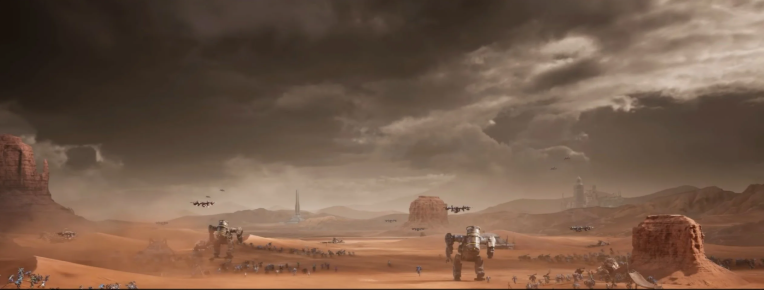In the world of gaming, few things are as exciting as a well-executed combat system. Whether it's the flow of a well-timed combo, the strategy behind a well-placed ambush, or the intensity of a high-stakes battle, combat mechanics are often the heart of any action-packed video game. In the case of Warborne: Above Ashes, a new and ambitious addition to the WAA Solarbite tactical RPG genre, combat mechanics are designed to not only immerse players in strategic warfare but to also challenge their wits, reflexes, and ability to adapt on the fly.
Warborne: Above Ashes promises to offer a blend of turn-based strategy, real-time action, and deep customization within a visually striking post-apocalyptic world. Developed by a team that’s passionate about blending intricate strategy with intense, visceral combat, Above Ashes introduces combat mechanics that are both innovative and familiar to fans of tactical RPGs. This article will explore the core combat mechanics of Warborne: Above Ashes, highlighting key features such as unit control, terrain advantages, resource management, and dynamic combat that together offer a fresh approach to the genre.
1. The Core Combat System: Turn-Based Tactical Action
At its core, Warborne: Above Ashes follows the classic turn-based combat system that has been a staple of the tactical RPG genre. However, this system is far from traditional. While players take turns controlling their units, the game incorporates real-time action elements that keep players on their toes. Here’s how the core combat system is structured:
A. Unit Control and Movement
Each player controls a set of specialized units on the battlefield. These units are categorized into different types—ranging from infantry, tanks, and helicopters, to specialized troops with unique abilities like medics and engineers. The battlefield is divided into a grid, and units are typically confined to movement within the grid.
Movement Points (MP): Each unit has a set number of movement points per turn, which dictate how far they can move on the battlefield. Some terrain types may hinder movement, such as dense forests or swampy areas, while open fields allow for rapid movement.
Unit Positioning: Positioning is key in Warborne: Above Ashes. Units can move and attack within the same turn, but the effectiveness of attacks often depends on the unit’s line of sight and the elevation of surrounding terrain. High ground offers an advantage in range and accuracy, while units in low terrain might be harder to hit.
Overwatch and Reaction Commands: Similar to other tactical games, units can be placed in overwatch, allowing them to react when an enemy unit comes into their line of sight. When an enemy moves into a unit's overwatch range, the unit automatically takes a shot at the enemy, making it a useful tactic for defending key positions or setting traps.
B. Action Points and Dynamic Combat Flow
While combat operates on a turn-based system, each turn is divided into Action Points (AP), which dictate how many actions a unit can take. These actions might include movement, firing, using an ability, or even repairing structures. Each action consumes a specific amount of AP, meaning players must carefully choose their actions for maximum impact.
Action Economy: For example, infantry units might consume fewer AP to move or shoot than heavier units like tanks. More powerful abilities, such as airstrikes or deploying barricades, might consume more AP. Efficient use of AP is crucial—doing so can make or break a battle, especially when resources are limited, and the situation is tense.
Quick-Time Actions (QTA): To introduce more excitement and player engagement, Warborne: Above Ashes includes quick-time events during combat. These moments require players to rapidly press buttons or complete quick tasks to enhance the effectiveness of an attack. For instance, a well-timed QTA during a melee attack might deal extra damage, or a successful quick-time event when firing an artillery strike might increase the blast radius or precision.
C. Abilities and Special Attacks
In addition to basic attacks and movement, each unit has access to a range of special abilities that can turn the tide of battle. These abilities, which vary from unit to unit, are governed by a cooldown system and require careful timing.
Ranged Combat: Units like snipers or long-range artillery have powerful ranged attacks. These attacks benefit from the line of sight and terrain advantage, such as shooting from high ground or using cover to conceal their position.
Close-Quarters Combat: Some units excel in hand-to-hand or close-quarters combat. These units can get up close to the enemy and use melee attacks, which can be devastating if used strategically. Special close-range abilities like charge or suppression allow players to disorient enemies and make them more vulnerable.
Support and Utility: Support units like medics, engineers, and signal officers provide essential battlefield support. Medics can heal injured units, while engineers can repair damaged vehicles or fortify positions. These roles are crucial to cheap WAA Solarbite maintaining momentum in battle, ensuring your forces can continue pushing forward.
Area-of-Effect (AoE) Abilities: Some units have devastating AoE attacks that can damage multiple enemy units at once. These abilities are particularly useful for clearing out clustered enemy forces or controlling strategic points in the battlefield. However, using AoE abilities comes with the risk of friendly fire, so careful placement is essential.

